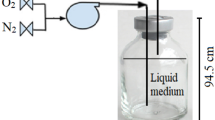Abstract
]A microbial consortium selected on 2-chlorobenzoate was shown to be able to also utilise 4-chlorobenzoate and 2,5-dichlorobenzoate as sole carbon source. The consortium adapted to grow on 4-chlorobenzoate, degraded the carbon sourcevia protocatechuate, whereas the same consortium degraded 2-chlorobenzoate and 2,5-dichlorobenzoate via 1,2- or 1,6-dioxygenation of the chlorinated ring. Moreover, no significant effects on the microbial growth due to the presence of chlorobenzoate mixtures were observed when 4-chlorobenzoate was the carbon source. Instead, when mete-substituted chlorobenzoates were added as co-substrates to 2,5-dichlorobenzoate, the growth of the consortium was totally inhibited, just as when the culture utilised for growth 2-chlorobenzoate. Uptake experiments with 2-chlorobenzoate-grown resting cells showed that 3-chlorobenzoate, 2,3-dichlorobenzoate and 2,3,5-trichlorobenzoate competed with 2-chlorobenzoate, entering the resting cells both preferentially and faster than the growth substrate, that was also impeded to enter. Also 3,4-dichlo-robenzoate and 3,5-dichlorobenzoate hindered the uptake of the growth substrate (2-chlorobenzoate and 2,5-dichlorobenzoate, respectively), but they did not enter themselves the cells. Finally, 3,5-dichlorobenzoate neither entered the 4-chlorobenzoate-grown cells nor hindered 4-chlorobenzoate uptake. The relationships between growth inhibiting effects and chlorosubstituent position on the aromatic ring of the chlorobenzoates supplied as co-substrates are discussed.
Similar content being viewed by others
References
Adriaens P., Focht D.D. (1991). Evidence for inhibitory substrate interactions during cometabolism of 3,4-dichlorobenzoate byAcinetobacter sp. strain 4-CB1. FEMS Microbiol. Ecol., 85: 293–300.
Baggi G. (2000) Ecological implications of synergistic and antagonistic interactions among growth and non growth analogs present in mixture. Ann. Microbiol., 50: 103–115.
Baggi G., Zangrossi M. (1995). Inhibition bymeta-substituted dichlorobenzoates inAlcaligenesdenitrificans which grows on 4-chlorobenzoate. Ann. Microbiol., 45: 185–189.
Baggi G., Zangrossi M. (1999). Degradation of chlorobenzoates in soil suspensions by indigenous populations and specialized organism: interaction between growth and non-growth substrates. FEMS Microbiol. Ecol., 29: 311–318.
Baggi G., Zangrossi M. (2001). Assessment of the biodegradative potential versus chlorobenzoates as single or mixed compounds in a stable microbial consortium. Ann. Microbiol., 51: 179–188.
Baggi G., Bernasconi S., Zangrossi M. (2005). 3-Chloro-, 2,3- and 3,5-dichlorobenzoate co-metabolism in a 2-chlorobenzoate-degrading consortium. Biodegradation, 16: 275–282.)
Baggi G., Bernasconi S., Zangrossi M., Cavalca L, Andreoni V. (2008). Co-metabolism of di- and tri-chlorobenzoates in a 2-chlorobenzoate-degrading bacterial culture: Effect of the position and number of halo-substituents. Int. Biodet. Biodegr, 62: 57–64.
Bouchez M., Blanchet D., Vandecasteele J.-P. (1995). Degradation of polycyclic aromatic hydrocarbons by pure strains and by defined strain associations: inhibition phenomena and cometabolism. Appl. Microbiol. Biotechnol., 43: 156–164.
Corbella M.E., Garrido-Pertierra A., Puyet A. (2001). Induction of the halobenzoate catabolic pathway and cometabolism of ortho-chlorobenzoates inPseudomonas aeruginosa 142 grown on glucose-supplemented medium. Biodegradation, 12: 149–157.
Hernandez B.S., Higson, F.K., Kondrat R., Focht D.D. (1991). Metabolism of and inhibition by chlorobenzoates inPseudomonas putida P111. Appl. Environ. Microbiol., 57: 3361–3366.
Miguez C.B., Greer C.W., Ingram J.M., MacLeod R.A. (1995). Uptake of benzoic acid and chloro-substituted benzoic acids byAlcaligenes denitrificans BRI 3010 and BRI 6011. Appl. Environ. Microbiol., 61: 4152–4159.
Smith M.R., Ewing M., Ratledge C. (1991). The interactions of various aromatic substrates degraded byPseudomonas sp. NCIB 10643: synergistic inhibition of growth by two compounds that serve as growth substrates. Appl. Microbiol. Biotechnol., 34: 536–538.
Stratford J., Wright M.A., Reineke W., Mokross H., Havel J., Knowles C.J., Robinson G.K. (1996). Influence of chlorobenzoates on the utilisation of chlorobiphenyls and chlorobenzoate mixtures by chlorobiphenyl/ chlorobenzoate-mineralising hybrid bacterial strains. Arch. Microbiol., 165: 213–218.
Stringfellow W.T., Aitken M.D. (1995). Competitive metabolism of naphthalene, metylnaphthalenes, and fluorene by phenanthrene-degrading Pseudomonads. Appl. Environm. Microbiol., 61: 357–362.
Weissenfeis W.D., Beyer M., Klein J. (1990). Degradation of phenanthrene, fluorene and fluoranthene by pure bacterial cultures. Appl. Microbiol.Biotechnol., 32: 479–484.
Author information
Authors and Affiliations
Corresponding author
Rights and permissions
About this article
Cite this article
Baggi, G., Bernasconi, S. & Zangrossi, M. Inhibitory mechanisms by chlorobenzoate mixtures in chlorobenzoate-degrading microorganisms. Ann. Microbiol. 59, 657–662 (2009). https://doi.org/10.1007/BF03179205
Received:
Accepted:
Issue Date:
DOI: https://doi.org/10.1007/BF03179205




